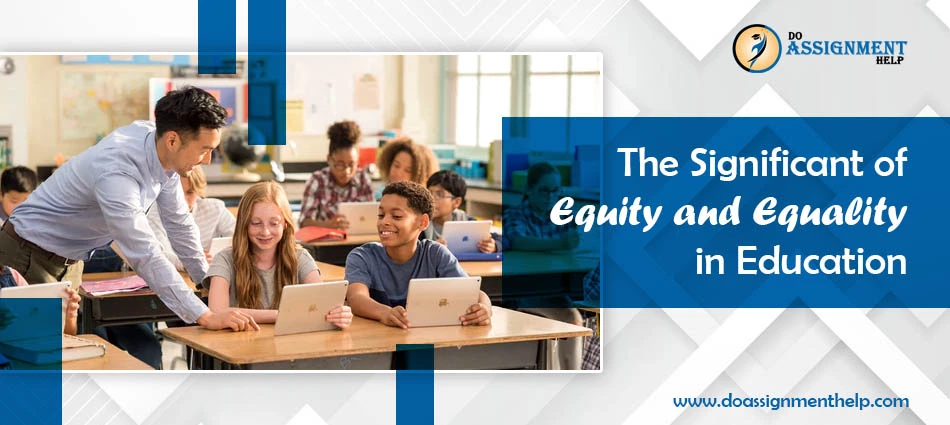To thrive in this world, every person requires four basic things. They include clothing, shelter, food, and quality education. According to Article 26 belonging to the Universal Declaration of Human Rights, every single individual has the right to acquire an education. Education should result in the complete development of the person’s personality. However, equality in education is a major issue today. Essentially, it means that every single person receives the same opportunities for their growth.
“Education is the most powerful weapon which you can use to change the world”.
…Nelson Mandela
It, in turn, will result in positive outcomes without any disparities. But there are plenty of people today who don’t gain access to opportunities for education. In this article, you’ll read about this issue and its significance in greater detail.
Also, Read: Benefits of Artificial Intelligence In Education
Table of Contents
What is Equality in Education?
Many people get confused between the terms equality and equity. You might think that both imply the same thing, namely fairness. However, there’s a bit of difference between the two. Equality in education implies that every student acquires the same resources to advance their career and life.
Every school should have the amenities needed for students to develop their potential. It can include similar funding to educational institutions all over the country. Only through it, every person will be able to attain a higher status and position. Put simply, it means that every student get access to the same thing, irrespective of the place from where they arrive.
The History of Equality in Education?
Educational opportunities for children need to be equal. It is because good education affects the life chances of a person with regards to labor market success, preparation for the democratic citizenry, and flourishing life. Secondly, the life chances of children shouldn’t be fixed by specific circumstances of their birth, like their social class, gender, and race.
Earlier, if a person was born as a woman, was part of an ethnic group or had a disability, then they did not experience equality in education. It was only in the end half of the 19th century that women were permitted to enter established universities. When the First World War ended, only two/thirds of children went to school. It was due to poverty and zero educational resources. Till the 1950s, one could find schools all over the United States fully segregated according to race. These educational spaces slowly opened because of changing social attitudes and the assimilation of other races. At times, these shifts to equality were natural social shifts. But in other times, these shifts were a result of government legislation. Legal cases like the Brows vs. Board of Education led to widespread changes that brought to the fore equality in education.
Also read about the American Education System
The Importance of Equality in Education
Equality in education is crucial to check that every student is receiving the exact level of attention, resources, and avenues for growth. Many students come from varied backgrounds. Often, they do not get equal opportunities from a young age. Children who begin their lives without equal access to different resources only face problems afterwards. If their parents have low socioeconomic status, they don’t take steps to make their child gain equitable access to resources.
Thus, equality in education is required for children to commence with positive educational outcomes. Equity allows equal opportunities to get adjusted for students who require more support and attention. People at the legislative level need to promote equality. They can do so by making sure that every school and college receive similar funding, materials, and quality of instruction.
Today, there are more resources for pupils who belong to wealthy families. You can find a separation on the lines of class and race. Students of color do not find good growth opportunities. So, they achieve lower outcomes and no chances to advance their life quality. Here are some points that’ll highlight the importance of equality in education.
- It will lead to the creation of an equitable society.
- It will ensure that every citizen in a democracy gets a good education.
- Educational equality will facilitate in the rapid growth of a nation.
- Equal opportunities to study and develop skills will widen ways to find talent among the people of a nation.
- Equality will support the building of a close connection between the manpower needs of society and the presence of highly skilled workers.
- It will result in economic mobility. The economy will display a huge disparity in accomplishments between varied social groups in its absence.
- Equal opportunities will promote social justice.
- A fair system of education will enable all students to build the knowledge and skills to become productive members of society. It, in turn, will facilitate enhanced economic and social outcomes for people, places, and country.
What Is Educational Equity?
There should be both equity and equality in education. Equity means that every student gets the resources to acquire the key skills of reading, writing, and doing simple maths. It measures the success in education through its outcomes. Essentially equity means fairness. If a child suffers from learning disabilities, they should receive more attention than someone who doesn’t experience these difficulties.
Students who are disabled require specific adjustments, and those who did not have opportunities so far may need additional help so they don’t lag behind other students. Equity in education also means all children get similar level of preparation by the time they turn adults. Education needs conscious attention. It should begin when the child is in kindergarten. It demands investing resources and care for children as per their needs. If they fall behind without support, they should get more support from their schools.
The current health crisis has brought forward various hurdles in achieving equity in education. When the schools shut down, racial disparities were observable. According to studies, students of color and those from low-income families turned 3 to 5 months behind in education compared to students from wealthier families.
Learn about: What Makes Online Education A Better Mode of Learning?
The Dimensions of Educational Equity
Educational equity is basically providing every student what they need to perform at an acceptable level. It has two major dimensions.
- Fairness – Fairness means ensuring that personal and social circumstances are not hindering the achievement of academic potential. It prevents discrimination with regard to gender, ethnicity, or socioeconomic status.
- Inclusion – Inclusion means a basic standard for everyone in society. For instance, there should be no person who shouldn’t be able to write, read, and do basic math. Those pupils who require more support and help must get it at all costs.
Many people use the two terms equity and equality interchangeably. But there is much difference between equity and equality in education. Equity implies giving each and every student access to equal resources so they can produce the best outcomes.
Even if each institution in a district gains similar funding, it won’t be sufficient to enable certain students to obtain a similar level of proficiency. It means that although there will be equality. But it won’t help in providing adequate equity.
The Difference between Equity and Equality in Education
A boost in educational equity can help overcome the lack of equality in education. The former ensures that the needs of students coming from disadvantaged sections are fully met. They should get the resources, tools, and support as per their needs. In contrast, equality is more in line with social issues. When a group aims to promote equality, it means that they are working for everyone to possess the same rights and avenues for growth.
However, equality does not take into consideration specific issues. For instance, providing every student with a take-home laptop will not resolve the problem of students who don’t have a strong net connection in their homes. So, even if the school is equitable, it will not end the struggles of a section of students.
On the other hand, equity means providing people with tools that fit their specific situations. According to the World Health Organization, equity implies the absence of remediable differences among sections of students. It can be said that equity is adaptable, individual-centric, and fair. In contrast, equality in education is generic, group-centric, and equal.
Techniques to Promote Equality in Education
Many factors result in inequality. But it’s possible to overcome them with specific strategies. They are as follows:
1. Betterment of the education system
It’s crucial for leaders and policy makers to understand the elements that affect children’s learning. These elements influence their success in early childhood. They should handle all these issues via legislative changes. It will ensure that every student receives positive outcomes from their learning.
2. Tailored education in the system
Another way to promote equality in education is providing personalized learning. In many schools, the faculty members simply fail students. Rather than this, they should take measures to intervene in certain areas. It will result in a rise in number of students who graduate. Parents should also impart enough support to children. If that’s not possible, they should prompt their wards to engage in various after-school programmers. It will lead to improved academic outcomes.
3. Removal of hurdles to education
The lack of early childhood resources is a major cause of inequality. Every student should gain access to help from the beginning. It, in turn, will increase the number of opportunities they receive. There should be no difference between the expectations of students. Every student should be expected to excel in their studies and achieve certain goals in their life. Policy makers should make efforts to know why small children are not attending school. Then, they should take relevant actions to curb the problem.
4. Create the right learning environment.
Classrooms should be such that they facilitate an environment that’s free from all bias. Teachers should make class rules by taking into account student suggestion. It will facilitate the creation of respectful and equal classroom. Apart from that, teachers should also create a seating plan that promotes equal participation of students of both genders. If some pupils do not participate in the class activities, the seating plan should be changed. Teachers should also not try to make things easy for male or female children. For instance, they should not give or ask easy questions in class to certain students and difficult questions to others. These measures will forge the perception of all students being equal in class.
5. How to Advance Equity in Education?
Educational equity is integral to the evolution of education systems. Its impact is visible at the classroom level. It is also felt throughout school districts. Gaps in academic outcomes are examined by assessing student performance on standard tests. It’s also analyzed through the access to higher academic courses and rates of graduation.
As per the National Centre for Educational Statistics, students who went to urban schools during 2015-16 had a greater chance to be in high-poverty districts. The distinct achievement gap between people from wealthier districts and those from high-poverty districts is a result of educational inequity between the various school districts.
Its possible to achieve equity in education through utilizing the right technology. It’s also through preparing educators with the necessary skills to teach children in various settings.
6. Some key ways to introduce equity
Educational leaders need to take concrete measures to encourage equity in schools. The approaches below can shift the teaching dynamics. They will lead to enhanced outcomes for different students.
- Culturally responsive teaching – Every educator must use this skill in classroom. They should give students from different backgrounds a safe environment favorable to their learning. They should break systemic biases and impart quality education as per students’ needs.
- Individualized learning – It involves using personalized lesson plans. It also includes advocating for those who require tailored educational opportunities.
- Support at an early age – Giving personalized support at an early age during education helps to achieve equity. Early intervention plays a massive role in the future outcomes of students. It helps in developing strengths and skills to overcome obstacles.
- Community engagement – Educators should involve communities and families in the learning of students. It, in turn, will motivate diverse voices to rectify systemic inequities. Thus, it will enhance educational equity for every student.
- Removal of prerequisites for advanced placement and honors classes – Entry obstacles remove many students of color to pursue higher courses. There is a need to assess students by their potential and use AP and honors to find children who are capable of making that educational leap. It is important to speak to every single student separately. Students can excel with adequate support, encouragement, and motivation.
- Revise existing curriculum – Assess curriculum to make sure that every student is reflected in it. To make every child feel more connected to the curriculum, it’s crucial to update it. It will help in enhancing learning opportunities and also boost content engagement and retention.
Final Words
Both equity and equality in education are vital. For achieving positive academic outcomes, equity in education is crucial. It allows every student to have same chances and opportunities. Equity ensures that equal opportunities are adapted to pave the way for giving support to those who need extra help. To provide a level playing field to children, equality is critical. It will only be possible when everyone in the educational process stand by equality and sees it as a basic value. To know more about it, you can also seek assignment help for expert help.
Also, Read: Has the Internet Changed The Modern-Day Education Scenario?
 Santa Clara, CA 95050
Santa Clara, CA 95050 





